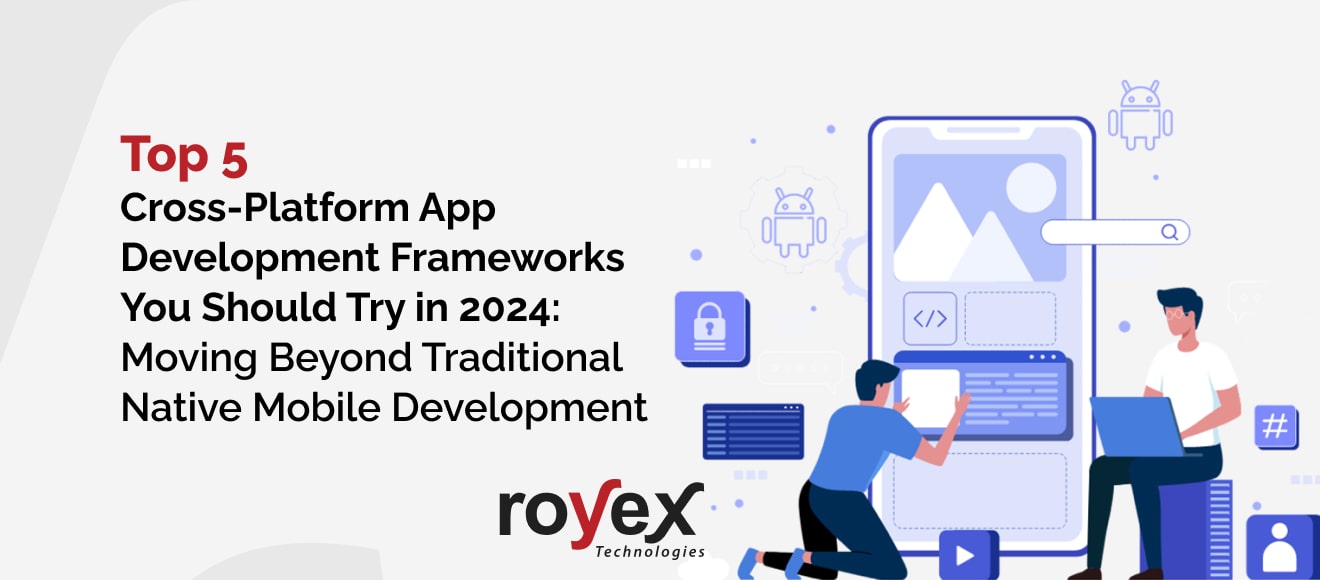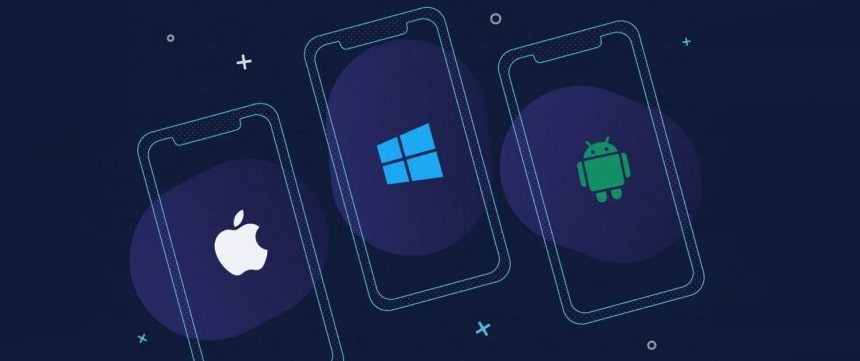
Top 5 Cross-Platform App Development Frameworks You Should Try in 2024: Moving Beyond Traditional Native Mobile Development
As an experienced mobile app development company in Dubai, we have seen how cross platform app development frameworks have transformed app development. In 2024, these frameworks continue to advance, providing developers like us with advanced tools and features that simplify the creation of smooth experiences on various platforms.
Being mobile app developers, we constantly search for efficient ways to work. The current mobile app market demands apps that function on both iOS and Android, increasing the need for high quality and efficient app delivery. This is effectively addressed by using cross platform app development frameworks.
The value of the global cross platform mobile app development market was estimated at $9.1 billion in 2021 and is projected to grow at a compound annual growth rate (CAGR) of 18.7% from 2022 to 2030, achieving a value of $32.8 billion by 2030. A study by Kinvey also found that cross-platform app development can save up to 27% in development costs compared to traditional native app development.
This article will cover the five best cross platform app development frameworks to try in 2024. I'll also give you a brief introduction to what cross platform app development is and its advantages.
What is Cross-Platform App Development?

Cross Platform app development is the process of creating apps that operate smoothly on various operating systems and devices like iOS, Android, and web browsers. This method differs from native app development, which uses different codebases for each platform. In cross platform development, developers use one codebase for all platforms. This strategy reduces development time, cuts costs, and simplifies maintenance.
Difference between Native and Cross-Platform App Development
While native app development is widely used, cross platform frameworks have advanced and are now closer in performance to native solutions.
Native App Development
-
These apps are created with specific programming languages and tools like Swift or Objective C for iOS, and Java or Kotlin for Android.
-
Native apps directly use device capabilities and APIs which results in the best possible performance and user experience.
-
These applications are available through the Apple App Store and Google Play Store, providing easy access for users to download and install.
CrossPlatform App Development
-
This method involves a single codebase that allows developers to build applications that run across multiple platforms. This can save time and reduce costs.
-
Enhanced consistency in user experience: With advanced cross platform technologies, apps can provide a similar user experience on various devices and platforms.
-
It is generally easier to maintain one codebase than several platform specific ones.
-
Although cross platform apps have improved significantly, they might still encounter some performance issues compared to native apps, especially in situations that demand a lot of resources.
Benefits of Cross-Platform Mobile App Development
Crossplatform app development is a great option for both businesses and developers because of these advantages:
-
Cost Effective: Cross platform development saves money because you can use the code for different platforms instead of writing new code for each one.
-
Quick to Launch: Apps developed this way can be finished and released faster since the same code works across multiple platforms, speeding up the process of getting products to users.
-
Uniform User Experience: These frameworks help create an app that looks and works the same on all devices, making it easier for users to interact with your app anywhere they use it.
-
Broad Audience Reach: By being available on various platforms, your app can attract more users without extra work for each platform’s requirements.
-
Simplified Upkeep: Managing just one codebase makes it simpler to update and fix any issues, saving time and effort in maintaining the app.
-
Debase, updates, and bug fixes are applied consistently across all platforms which cuts down on maintenance work and leads to a smoother development process.
Top 5 Cross-Platform App Development Frameworks You Should Try in 2024
Flutter

Flutter has become very popular for making apps that work across different platforms. A 2022 Stack Overflow survey found that 66.9% of developers love working with Flutter, making it the second favorite framework. Flutter uses Dart as its programming language and offers a wide range of widgets and tools. These help build fast and good looking apps for iOS, Android, and web platforms. One of Flutter's great features is its hot reload capability, which lets developers immediately see the changes they make in their code on the actual app. Its comprehensive documentation also makes Flutter appealing to many programmers. Big organizations like Google have chosen Flutter for creating several applications, such as Google Ads and Google Stadia. Other popular websites and apps built with Flutter include:
- Alibaba
- Google Pay
- Toyota
- Groupon
Features of Flutter
-
Hot Reload: This feature helps developers see immediate changes in their app without needing to restart or lose any progress.
-
Widgets and Material Design: Offers a wide variety of customizable widgets that follow Google's Material Design principles, making it easy to build attractive and consistent user interfaces on different platforms.
-
Single Codebase: Developers can create applications for various platforms like iOS, Android, web, and desktop using just one codebase. This approach saves time and reduces the effort needed for maintenance.
-
Native Performance: The Skia rendering engine compiles code straight into machine code. This provides fast performance and smooth graphics, even in apps with heavy visuals.
-
Extensive Documentation and Community: There is ample documentation, tutorials, and a supportive community of developers available. These resources help with learning and solving problems while encouraging developers to contribute and expand the ecosystem.
React Native
React Native, developed by Facebook, is a leading cross platform framework that enables developers to create mobile apps with a native feel using JavaScript and React. The 2022 Stack Overflow Developer Survey reports that 38.9% of developers utilize React Native, making it the most favored framework for cross platform mobile development. It boasts a thriving community, impressive performance, an extensive range of third party libraries, and smooth integration with native components. Many well known companies such as Facebook, Instagram, Uber, Airbnb, and Bloomberg have implemented this framework extensively. Some popular mobile apps and websites built with React Native include:
- Facebook Analytics
- Skype
- Discord
According to a report by Statista, the global React Native developer population is projected to reach around 2.3 million by 2024, reflecting the growing popularity and adoption of this cross-platform framework in the mobile app development space.
Features of React Native
-
Live Reloading: This feature lets developers immediately observe modifications they make in the code on the active app, eliminating the need for a complete rebuild.
-
Flexible UI: Offers a wide range of customizable UI components along with options to craft unique components, making it easier to construct intricate user interfaces.
-
Code Reusability: This functionality grants developers the convenience of using much of the same code for both iOS and Android platforms, saving time and reducing workload.
-
Platform Awareness: Provides access to native APIs and elements, delivering an authentic native experience while also leveraging shared code across platforms.
-
Large Community: Supported by a vast and dynamic community that offers numerous third party libraries and tools which speed up development processes.
Xamarin

Xamarin is a cross platform framework that utilizes C# and .NET for building apps across iOS, Android, and Windows. A 2022 survey indicated that approximately 1.4 million developers are using Xamarin, with an anticipated annual growth of 19%. The framework provides a powerful set of tools and APIs which enable developers to write one codebase for multiple platforms without sacrificing the native performance or functionality of the applications. Xamarin has been widely adopted by enterprises and organizations, including
- Microsoft
- Slack
- The World Bank
- Halliburton
- Trello
Some popular mobile apps and websites built with Xamarin include The World Bank's Data Hub, FedEx's mobile app, Insurely's insurance app, Olo's digital ordering platform for restaurants. A report by Statista estimates that the global Xamarin developer population will reach around 2.8 million by 2024, reflecting the growing popularity and adoption of this cross-platform framework, particularly in the enterprise sector, where its integration with .NET and C# is a significant advantage.
Features of Xamarin
-
NET Standard Support: This feature lets developers use the same code on several platforms like iOS, Android, and Windows by employing .NET Standard libraries.
-
Native UI Controls: This grants access to the specific UI controls and APIs of each platform, providing apps with an authentic native appearance.
-
Visual Studio Integration: This allows for smooth integration with Visual Studio, creating a comfortable setting for developers who use C#.
-
Xamarin.Forms: This tool helps in developing user interfaces that can operate across multiple platforms from a single set of code, yet it permits modifications specific to each platform.
-
XAML Support: By enabling XAML usage for interface design, this supports developers already skilled in XAML to efficiently construct cross platform applications.
Ionic
Ionic is an open-source UI toolkit for creating high quality, high performance apps for both mobile and desktop platforms, using web technologies such as HTML, CSS, and JavaScript. The 2022 Ionic State of Vue Report highlights its status as the leading framework for developing Progressive Web Apps (PWAs) and cross platform applications. Over five million applications have been created with this framework. Ionic boasts an extensive collection of UI components. It works seamlessly with well known frameworks like Angular and React and excels in developing PWAs.
Many prominent businesses including Salesforce, Burger King, Amtrak, Pacifica, and Untappd rely on Ionic for their app development needs. Notable apps created using Ionic are Sworkit for fitness routines, Pacifica for mental health support, the Amtrak travel app and the Untappd app used to rate beers. A forecast from Statista projects that by 2024 there will be approximately 1.6 million developers worldwide using Ionic, indicative of its growing appeal and widespread use in application development across various industries. The ORM framework plays a critical role in creating PWAs and hybrid mobile applications.
Features of Ionic
-
Web Technologies: Developers can create applications using web elements such as HTML, CSS, and JavaScript. This approach allows them to write code once and use it on many platforms.
-
Ionic Components: This feature supplies a wide variety of UI components designed for mobiles that maintain the same appearance and behavior on different devices.
-
Integrations: It connects effortlessly with major frameworks like Angular, React, and Vue. Developers can choose their favorite framework to work with.
-
Progressive Web Apps (PWAs): Supports building Progressive Web Apps that users can install on their devices. These apps function offline for a user experience similar to native apps.
-
Ionic CLI: Comes with an effective commandline interface (CLI) that makes developing tasks like setting up projects, building them, and rolling them out easier.
NativeScript
NativeScript is an open-source framework that helps developers create real native mobile apps using JavaScript, TypeScript, or Angular. The NativeScript website reports over 4 million downloads and a vibrant community of more than 60,000 developers. This framework lets you use native APIs and UI components directly, making sure the app feels native and allows sharing code between platforms. NativeScript has been adopted by various companies and organizations, including
- Progress Software (the company behind NativeScript)
- Rocket Insights
- Baker Hughes
Some popular mobile apps built with NativeScript include the Progress Telerik UI for NativeScript suite of UI components, the Star Track by Vue Vixens app, and the Baker Hughes Internal Tools app. A report by Statista estimates that the global NativeScript developer population will reach around 1.1 million by 2024, reflecting the growing popularity and adoption of this cross-platform framework for building truly native mobile apps using web technologies.
Features of NativeScript
-
Truly Native: Renders user interfaces with the native platform's rendering engine, resulting in a truly native look and feel.
-
Access to Native APIs: Provides direct access to native APIs and platform capabilities, enabling the development of feature-rich, performant apps.
-
Code Sharing: Allows sharing of code across iOS and Android platforms, reducing development time and effort.
-
Angular/Vue.js Integration: Offers seamless integration with popular frameworks like Angular and Vue.js, leveraging developers' existing skills.
-
Live Sync: Enables developers to instantly see changes in their code reflected in the running app, streamlining the development process.
Choosing the Right Framework
The ideal framework for your project varies based on your unique requirements and preferences. Think about aspects such as the intricacy of your app's user interface, the expertise of your team, and the performance you aim to achieve. Feel free to try out different options! In 2024, the landscape for cross platform development is always changing. All these frameworks are consistently updated and enhanced, ensuring you pick an option that stays relevant. Choosing the correct framework helps you transform your design idea into a unified, effective application accessible on iOS and Android platforms.
Why Choose Royex Technologies for Cross-Platform App Development in Dubai
You can hire us to develop high-quality mobile apps in Dubai. We have an experienced team of mobile app developers who have been working together for years now. We’ve successfully developed hundreds of projects for our clients and become a leading mobile app development company in Dubai.
Our clients and portfolio speak of the quality and commitment of our company. You can check our website for more details. Email us at info@royex.net or call on +971566027916 with your requirements.





